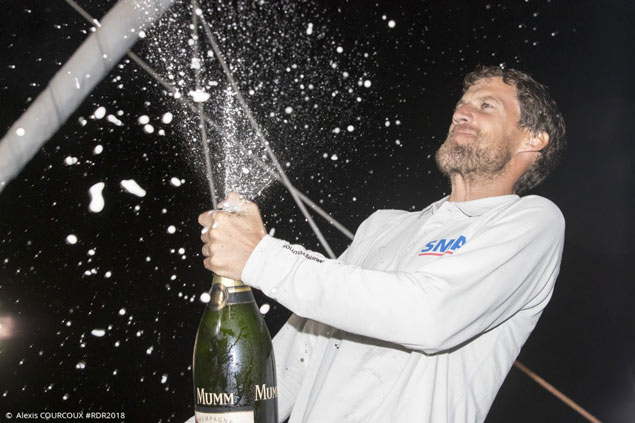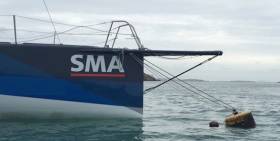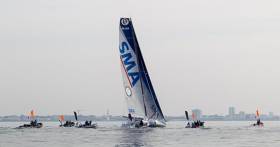Displaying items by tag: SMA
From Disaster In The Azores To Route To Rhum Victory, Paul Meilhat Is A True Offshore Success Story
Paul Meilhat’s IMOCA victory in the Route du Rhum over the weekend is all the sweeter as he achieved it in the same boat he’d feared lost on an earlier transatlantic crossing almost three years ago.
The French yachtsman had been airlifted off SMA on 15 December 2015 and the 60-footer SMA was abandoned in the Azores — though it drifted towards Ireland in the following weeks and was eventually recovered some 100 miles off the coast and berthed in Crookhaven.
“It’s amazing to think that our efforts three years ago to recover that boat against pretty tough odds have now resulted in the boat and Paul winning the Route du Rhum,” says Kinsale-linked offshore specialist Marcus Hutchinson, who was Paul’s project manager for the first three years of his IMOCA campaign.
 Paul Meilhat (SMA) Route du Rhum's winner Photo: Alexis Courcoux
Paul Meilhat (SMA) Route du Rhum's winner Photo: Alexis Courcoux
“He was a successful Figaro sailor when he turned to the IMOCA scene then and is now clearly in the top flight there, too,” Marcus adds.
Despite that serious incident in 2015, which left Paul with a fractured pelvis, Marcus said the Frenchman only grew with confidence over the years he was in charge of the project.
That was most obvious when, before a keel ram failure forced retirement in January last year, Paul sailed his way into third place in the Vendée Globe without the foils and newer boat technology employed by the rest of the field since his boat, in the hands of Francois Gabard, previously won that circumnavigation challenge.
Later in the year, Paul secured second in the Transat Jacques Vabre, again putting his foiling competitors to shame. It was at this time that his boat’s sponsor SMA decided to withdraw from offshore racing, meaning the most recent 12 months would be the last under their livery.
It’s quite the capper on that relationship that Paul has sailed SMA to victory in the Route du Rhum, says Marcus.
“I’m very happy for the team. I’m no longer a part of that group, but it is a small world and we see each other almost every day. Paul’s boat captain, for example, is a lodger in my house.”
Looking closer to home, Marcus sees the achievements of people like Paul Meilhat as an inspiration for Irish sailors with offshore ambitions, particularly with a new Olympic class on the cards for Paris in 2024.
“Irish offshore sailing is pretty well placed to step up to the next level and prepare to be competitive in 2024,” he says. “The kind of boat that will be used for that regatta is not really relevant to understanding and improving at the top end of offshore racing.
“The racing circuit in France, with the super competitive Figaro circuit in particular, is the place to be if you have any ambitions. Joan Mulloy and Tom Dolan are currently fundraising in Ireland for next year’s Figaro circuit and potentially an Irish stopover for that race, too.”
Marcus adds that 50 Figaro Beneteau 3s have already been sold and will be released in January.
“I have two of them in my academy. These are the platforms to train on. Anyone who has ambitions for 2024 should start to consider getting involved in this type of racing.”
Meilhat Confirms Comeback with Fourth Placed Finish in Kinsale Repaired Yacht in New York – Vendée Race
Six months ago Paul Meilhat (SMA) was airlifted off his boat to the Azores and hospitalised after fracturing his pelvis and rib during a sail change in big seas during the Transat St Barth/Port-La-Forêt. His yacht was located in the Atlantic by Marcus Hutchinson and towed into Crookhaven and repaired in Kinsale. Today the 34-year-old Vendée Globe rookie from Brest finished in 4th place in the inaugural 2016 New York – Vendée (Les Sables d’Olonne) Race.
Meilhat crossed the finish line off Les Sables d’Olonne this morning at 09:59:27 (French time). He covered the course in 10 days 12 hrs 19 mins and 27 seconds. He finished 19 hours 21 minutes and 35 seconds behind the winner, Jérémie Beyou, (Maître CoQ).
Meilhat sailed 3,682 miles at an average speed of 14.59 knots. The theoretical racecourse was 3,100 miles, but Meilhat has sailed the furthest of the finishers so far, 220 miles more than Beyou.
He has just completed his first two solo Transats in an IMOCA in just over a month - after racing to New York in The Transat – and has finished fourth in both.
“We’ve done two transats in just over a month – that’s happiness,” he said. “I still have work to do but I’m starting to have fun. The mid-Atlantic was true to its reputation with strong winds, and having to manage a depression. That was something I hadn’t done before and it will resemble what we’ll be going through in a few months in the South Seas (for the Vendée Globe).”
SMA is the former Macif, which smashed the Vendée Globe record in 2012-13. It is the first non-foiling boat home – foilers have won the last three transatlantic races now – and was never quite able to keep pace with the lead group of three, who finished yesterday. But given his relative inexperience, and recent trauma, he sailed his own race impressively. He has been alone, sometimes separated by over 150 miles, since he moved into 4th place on Saturday as Vincent Riou (PRB) and Tanguy de Lamotte (Initiatives Coeur) suffered technical problems.
The group chasing him have had to take a similarly northern route up to the Brittany coast, in glassy flat seas and erratic winds, before they descend to Les Sables d’Olonne. At the 13:00 UTC ranking, Riou, in 5th, led de Lamotte by 22 miles, with Kojiro Shiraishi (Spirit of Yukoh) a further 30 miles back. Today’s easterly winds will rotate north in the night and northwest tomorrow and will be fluky to the finish, so nobody will be relaxing quite yet.
“It’s amazing, we’re all battling it out together,” de Lamotte said. “Kojiro really surprised me, the way he’s sailed so cleanly, he’s got good speed for not having the boat for so long. It’s a great performance for him. I’m quite used to the light winds – and it is summertime in the Bay of Biscay. I did six tacks yesterday, which was really demanding, but it’s quite fun getting the boat going.”
Riou is predicted to arrive anywhere between 04:00 and 10:00 on Friday morning with the other two coming in between 12:00 and 17:00. And Fabrice Amedeo (Newrest - Matmut), in 8th keeps eating up the miles, making another 25 so far today to come within 35 of Shiraishi.
“I’ve got 3 knots of south-east wind at the moment and I really, really, really want a Code 0, can you send me one? Will the Race Office allow that?” Shiraishi asked plaintively earlier. “I think it’s the same for everyone out here. If I had a Code 0 maybe I could compete with Tanguy, but I’ve got an A3 up…”
500 miles behind them, in the battle of the wounded boats, Morgan Lagravière (Safran) leads Yann Eliès (Quéguiner – Leucémie Espoir) by just 10 miles and has gybed away toward the north coast of Spain. After the gamble of heading deep south of the Azores did not pay out, Jean-Pierre Dick (StMichel - Virbac), keeps losing ground and is now almost 90 miles behind Eliès. But the race is not over and the gaps are likely to reduce in the coming days. Their westerly wind is forecast to gradually turn south-west and then ease off for their arrivals, which are now predicted to be overnight on Saturday and into Sunday.
Behind them the two backmarkers are finally into a good stride, with south-westerlies driving them up to 18 knots, as they try to stay ahead of a front as long as possible. Pieter Heerema (No Way Back) is just 5 miles behind Conrad Colman (100% Natural Energy). They are predicted to arrive on Sunday in the late afternoon.
SMA IMOCA Round–the–World Yacht Ready to Depart Kinsale
The SMA 60 recovered 100 miles off the Irish coast three weeks ago has been undergoing repairs afloat in the County Cork harbour of Kinsale. The team have been making the round the world yacht seaworthy again and despite of damage to its mechanical propulsion system, the 60–footer is ready to sail again with a new sail wardrobe.
Since Paul Meilhat was airlifted off SMA on 15th December, during the transatlantic Race in which Ireland's Enda O'Coineen finished third, the IMOCA class yacht drifted up from the Azores to Ireland over the past twenty days, during which the SMA team attempted several recovery operations, in spite of some horrendous weather.
The French led recovery crew plan to depart Kinsale for the French port of Port La Forêt next week.
French SMA Yacht Recovered & Brought to Crookhaven
An 60–foot round the world French racing yacht is berthed in Crookhaven Bay in County Cork this morning having been abandoned mid–Atlantic three weeks ago and brought to the Irish harbour by a recovery team that included Kinsale's Marcus Hutchinson.
Since Paul Meilhat was airlifted off SMA on 15th December, during the transatlantic Race in which Ireland's Enda O'Coineen finished third, the 60-footer has drifted up from the Azores to Ireland over the past twenty days, during which the SMA team has attempted several recovery operations, in spite of some horrendous weather.
On 5th January, the boat was finally recovered 100 miles off the coast of Ireland. SMA is now safe in Crookhaven Bay in SW Ireland. On board, the boat captain, Marc Liardet and his team are trying to sort the boat out. Their goal is to get her back to France and to Port La Forêt as soon as the weather allows.
In early January, two operations were set up at the same time with Mer Agitee, the owner of the monohull and the boat's insurers, Pantaenius. On 4th January, on a boat was chartered by the insurance company with the ocean racer, Adrien Hardy on board. He managed to get aboard SMA, in some very rough conditions in 40 knots of wind and 20-foot high waves, while the Mer Agitee shorte team joined in aboard an Irish tug.
As the Mer Agitee predicted, after following the progress of SMA thanks to her Argos beacon, following on from the operation to rescue Paul Meilhat, the mast was still in place.
The recovery team in Ireland:
Marcus Hutchinson, Marc Liardet, Anne Liardet, Antoine Brunel and Damien Guillou.






























































